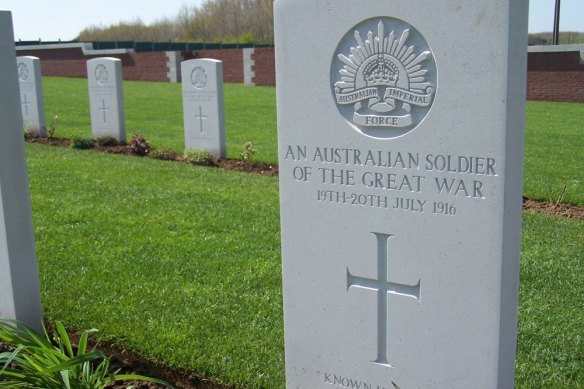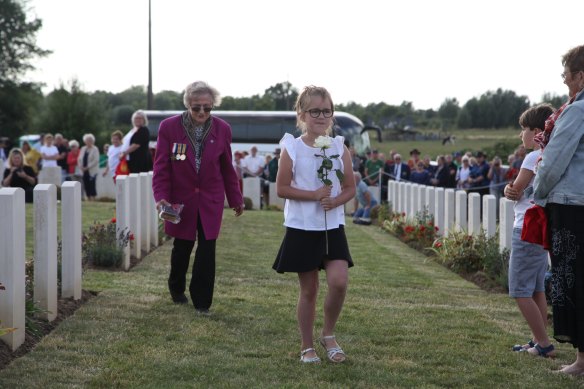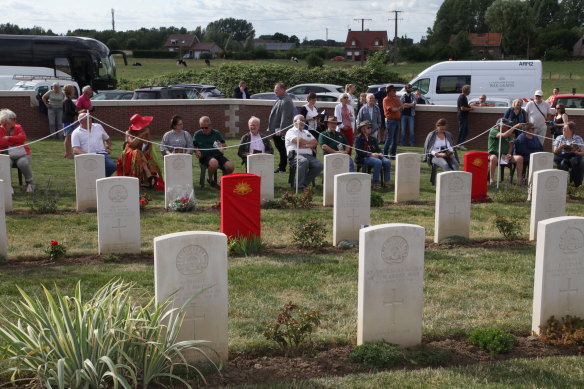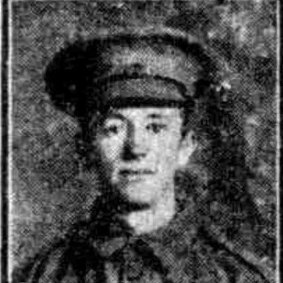‘A very sad story’: After 107 years, seven Australians can finally rest in peace
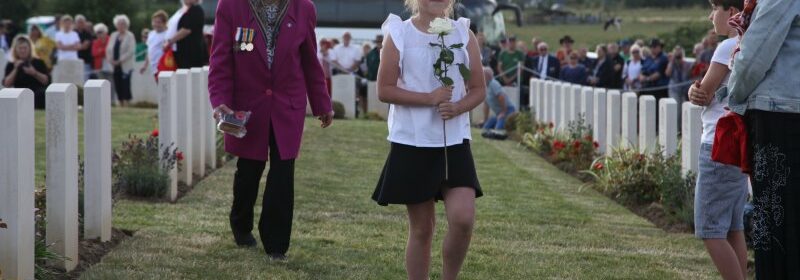
Save articles for later
Add articles to your saved list and come back to them any time.
Fromelles: The mission began at 6pm on July 19, 1916. The newly arrived 5th Australian Division was on the left, the British division on the right.
It was an unmitigated disaster. The heavy fire from machine guns and artillery, and the German counter-attacks, took the heaviest of tolls. The losses incurred at the Battle of Fromelles would make this the most expensive in terms of lives lost over a 24-hour period in Australia’s war history.
Seven Australian diggers killed at Fromelles have been honoured at the Pheasant Wood Military Cemetery.
Of the 2000 men who died over that day – most of them boys really – many than half would lay in mass graves in northern France for almost a century. After the battle, the Germans buried 250 bodies behind their lines.
But now, one by one, their dignity and identity are being restored.
At the windswept Pheasant Wood Cemetery, 16 kilometres west of Lille near the Belgium border, dogs barked and cows grazed in the nearby long grass as families gathered to honour their fallen relatives. The mayor of Fromelles, Jean-Gabriel Masson, told the audience the town would never forget the contribution of those men.
There are 225 Australians buried at the cemetery, of which 59 remain unidentified. Two are unidentified British soldiers and 23 are entirely unidentified soldiers.
Suzanne Chapman, a retired lawyer from Melbourne, at the Fromelles ceremony to honour her uncle, Edwin Gray.
The identity of the seven more soldiers, recovered from unmarked mass graves in 2009, were confirmed recently through a range of evidence collated by anthropologists, archaeologists and DNA specialists which was analysed by the Australian Army’s Unrecovered War Casualties Team.
Some gathered were nieces of the dead. Some cousins twice or three-times removed. A handful had grown up on the tales of their heroic relatives, while others were learning about them for the first time. But it didn’t seem to matter. This, after 107 years as an unknown, was a moment for them.
There was Oscar Baumann, 20, a joiner from Adelaide. William Stephen, 28, a grocer from Sydney. Richard McGuarr, 27, had come off the family dairy farm near Lismore in northern NSW. Alexander Page, 28, a milk carter from Perth.
Walter Grace, 23, was a labourer from Brisbane. Edwin Gray, 30, worked as a driver and chauffeur before he made the journey from Riverton in South Australia.
Maurice Claxton, 24, a horse driver from St Arnaud in western Victoria, was killed while his younger brother, Theodore, was captured by the Germans.
By September, their father John had received a postcard from his youngest son, advising that he had been taken prisoner. There had been no updates by military authorities. In a letter home, Theodore said he didn’t know where Maurice got to even though “we were together until we made the charge, when we got separated.“
While Theodore survived and returned home in 1919, Maurice’s fate remained a mystery.
But courtesy of genealogical testing and meticulous research, his decedents could give him the farewell he deserved.
Luke Claxton, the great nephew of Maurice, set out to research the history of the two brothers following the death of his grandmother. After contacting the Fromelles Association his father was asked to submit a DNA test.
Crowds gathered in Fromelles to mark the 107th anniversary of the deadly World War I battle on Wednesday.
“It all went from there really,” he said on Wednesday. “I didn’t realise the importance of this battle really until that moment. It’s probably something that more people should know. What happened here and what they went through.”
Corporal William “Billie” Stephen was described by a comrade as “a good man” who “acquitted himself very well”. His mate James O’Brien, who witnessed his death, said: “Stephen was in one of the trenches taken on the night of July 19th at Fleurbaix when he was shot through the head as he stood by my side.”
Private Edwin Gray was killed at Fromelles on July 20, 1916.
Relatives in Canada received an email last year asking if they would provide a DNA sample to confirm it was Stephen. They didn’t even know they had Australian relatives – even if it was a second cousin three times removed.
“I did not know any family who went to Australia, I knew we went to the United States and Canada. At first I thought it might be a scam, but here we are,” Lorraine Stephen said.
“But it was an incredible honour to be here. Both my grandfathers served in the First World War but I knew nothing of Fromelles.”
Suzanne Chapman, a retired lawyer from Camberwell, in Melbourne, travelled to the Western Front to honour her uncle, Private Edwin Charles Gray, who was 30 years old when he was killed.
In February 1917 Edwin’s eldest brother Alfred, who had enlisted in September 1914, wrote to the Red Cross having heard his brother might be a prisoner of war. The Gray family was officially notified Edwin was killed in action on April 2, 1917, though they held out hope he might be found.
“It’s a very sad story,” she said. “We never talked about it as a family I guess because they didn’t know what happened to him or where he was.”
She said her grandmother Ada wrote letters asking for information but there was nothing. The family was contacted about volunteering in 2008. Gray’s identity was not confirmed until November last year.
She said it would have meant the world to her father, Herbert and grandmother to know family was present for the graveside ceremony.
“I use the word closure and that is what a proper grave for Edwin will give me and my family.”
Get a note directly from our foreign correspondents on what’s making headlines around the world. Sign up for the weekly What in the World newsletter here.
Most Viewed in World
From our partners
Source: Read Full Article
